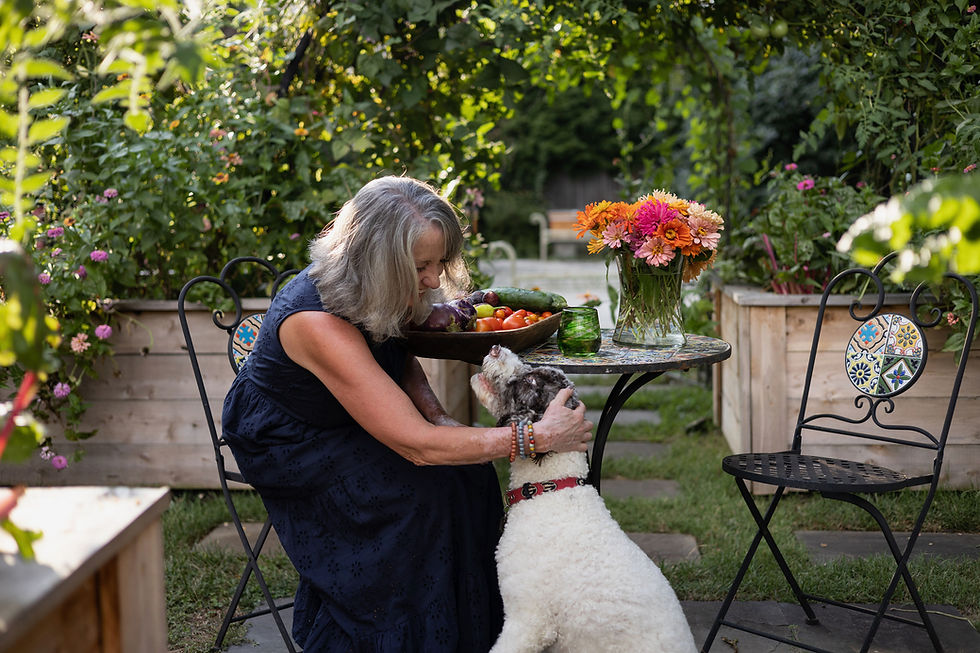A Butterfly in the Garden: Why Eastern Tiger Swallowtails Are Arriving Early (and How to Welcome Them)
- Sara Rubens

- May 30
- 4 min read
Updated: Jul 2
Have you noticed something fluttering through your garden a little earlier than usual this year?
I had my first sighting just a few days ago.
I was watering my herb pots—still half-asleep with coffee in hand—when a flicker of yellow danced through the air, landing softly on my dill.
And there it was: an Eastern Tiger Swallowtail, one of North Carolina’s most beloved garden guests.

Every year, these striking butterflies signal something special.
Not just the turn of the seasons, but a reminder that our gardens are part of a larger, living world—one that’s constantly shifting, adapting, and surprising us.
And this year, they’re arriving a bit ahead of schedule.
🦋 Why They're Showing Up Early
Thanks to a mild North Carolina spring, butterflies in the garden—especially swallowtails—are beginning to emerge and explore sooner than usual.
Warmer temperatures mean that eggs laid last season are hatching earlier, and adult butterflies are beginning their seasonal search for nectar, mates, and the perfect place to lay their eggs.
If you’ve noticed a few extra winged visitors flitting about your parsley or fennel, you’re not imagining things.
You’re hosting a garden party—and butterflies are on the guest list.
🌿 What Butterflies Are Looking For in Your Garden
One of the beautiful things about the Eastern Tiger Swallowtail is that it’s not very picky—especially when it comes to plants many North Carolina gardeners are already growing.
These butterflies lay their eggs on certain host plants that their caterpillars will later rely on for food. And lucky for us, these hosts are also some of the most delicious herbs we use in the kitchen.
If you have any of these growing, you might be supporting the next generation of pollinators:
✅ Dill
✅ Fennel
✅ Parsley
These herbs do double duty: they flavor our meals and serve as nursery plants for swallowtail caterpillars. You might even call them butterfly incubators. 🐛
So if you’ve got a sunny corner in your yard or an empty pot on your patio, why not dedicate a little space to a butterfly patch?
It doesn’t have to be fancy.
It just has to be welcoming.
🏡 How to Create a Butterfly-Friendly Garden in North Carolina
You don’t need a sprawling garden to make a difference. Even a few simple changes can turn your space into a soft landing spot for these fluttering friends.
Here are some gentle, tried-and-true ways to invite them in:
🌿 1. Let a Little Go Wild
We gardeners love to prune, tidy, and deadhead—but when it comes to pollinators, a little wildness can be wonderful.
Let your herbs flower. Dill and parsley blooms are especially attractive to butterflies, bees, and other beneficial insects.
Even a slightly overgrown corner can become a buzzing, fluttering haven.
🚫 2. Skip the Sprays
This one’s especially important if you’re hoping to support butterflies from egg to adult.
Even organic pesticides—while better than conventional ones—can be harmful to delicate butterfly eggs and young caterpillars. These early life stages are incredibly vulnerable.
So before reaching for a spray bottle, pause.
Ask yourself: Could this be part of the transformation process?
⏳ 3. Be Patient With Nibbled Leaves
We tend to think of holes in leaves as a bad thing. But sometimes, they’re a sign that something extraordinary is happening.
If you see chew marks on your dill or parsley, take a closer look. You might find a swallowtail caterpillar hiding in plain sight.
Their transformation is one of nature’s quiet miracles—and your garden gets to be part of the story.
🥗 Bonus: These Herbs Are Delicious for You, Too
One of my favorite parts of growing a butterfly-friendly garden is that it doubles as a fresh herb patch for the kitchen.
These aren’t just good for butterflies—they’re flavorful, versatile, and easy to add to all sorts of springtime dishes.
Here are a few simple ways to use dill, parsley, and fennel:
🍳 Add chopped herbs to egg or potato salad for a fresh twist
🥕 Sprinkle fennel fronds over roasted carrots or sweet potatoes
🐟 Use parsley as a bright topping for grilled fish or tofu
🥗 Whisk dill into a creamy or vinaigrette-style salad dressing
It’s one of those rare garden wins: a treat for you, and a meal for the next butterfly generation.
🌞 The Bigger Picture: Why This Matters in North Carolina Gardens
In North Carolina gardening, we’re lucky to experience long growing seasons, rich biodiversity, and a beautiful overlap of wild and cultivated spaces.
Welcoming butterflies into your garden is more than just an aesthetic joy—it’s part of maintaining a healthy, thriving ecosystem right outside your door.
Pollinators like butterflies and bees support everything from vegetable harvests to flower blooms. And when we create intentional spaces for them, we become stewards of something much bigger than ourselves.
It’s not just about growing food or flowers.
It’s about growing connection.
🌼 Your Invitation to Grow Something Beautiful
If you’ve got a moment this week, take a walk through your garden or patio. Look closely. Listen. Breathe in what’s blooming.
And if you see a butterfly? Smile. You’ve built something worth visiting.
Follow me on Instagram @seed2sanctuary.
Feel free to comment and share your favorite butterfly sighting this season.
I’d love to hear who’s been visiting your garden.




Comments